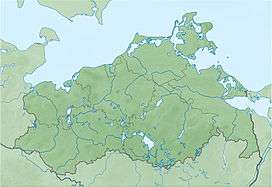Königsstuhl (Rügen)
| Königsstuhl | |
|---|---|
|
The Königsstuhl – seen from Victoria's View (2012) | |
| Highest point | |
| Elevation | 118 m above sea level (NN) (387 ft) |
| Coordinates | 54°34′23″N 13°39′45″E / 54.57306°N 13.6625°ECoordinates: 54°34′23″N 13°39′45″E / 54.57306°N 13.6625°E |
| Geography | |
 Königsstuhl | |
| Geology | |
| Mountain type | Chalk |
The Königsstuhl (King's Chair) is the best-known chalk cliff on the Stubbenkammer in the Jasmund National Park on the Baltic Sea island of Rügen. It lies at 118 m above sea level (NN).

In 2004 the Königsstuhl was incorporated into the terrain of the Königsstuhl National Park Centre. It can be reached along a cliff top path, 11 kilometres long in total, that runs from Sassnitz to Lohme, or from the large car park in Hagen (in the municipality of Lohme) 3 km away. Since 2004, entry to the National Park Centre and hence access to the Königsstuhl has been subject to a charge.
The narrow yet massive granite steps, that lead to the plateau on the Königsstuhl, 200 m² in area, lie over the site of what is suspected to be a Bronze Age barrow. From the plateau is a sweeping view of the Baltic Sea. The Königsstuhl itself is best seen from the viewing point of Victoria View (Victoria-Sicht) to the south.
There is a legend that the name Königsstuhl ("King's Chair") goes back to an event in 1715 when the Swedish king, Charles XII is supposed to have commanded a sea battle against the Danes from this spot. The battle tired the ruler so much, such that he needed to take a chair.
However, the name Königsstuhl was used in a travel report by the vicar, Rhenan, in 1586, who had been tasked by the Pomeranian duke to find mineral springs, thus it is clear that it had been named much earlier.
According to a legend, the name is actually derived from a custom whereby in ancient times the person elected king was the first to climb the cliffs from the sea and sit in the chair on the top.
- Victoria-Sicht (Victoria's View) and Königsstuhl (King's Chair) from above
 View towards Stubbenkammer, the area around the Königsstuhl
View towards Stubbenkammer, the area around the Königsstuhl View from the beach
View from the beach
(around 1900)_1966%2C_MiNr_1180.jpg) Königsstuhl as featured on an official GDR stamp in 1966
Königsstuhl as featured on an official GDR stamp in 1966 Postcard of Königsstuhl, 1927
Postcard of Königsstuhl, 1927 Before 1970
Before 1970 On top of the Königsstuhl, at 118m above sea level
On top of the Königsstuhl, at 118m above sea level View from the Königsstuhl, northwards
View from the Königsstuhl, northwards
External links
| Wikimedia Commons has media related to Stubbenkammer. |
| Wikisource has original text related to this article: |
- Jasmund National Park pictures and information about the chalk cliffs (English)
- nationalpark-jasmund.de (German)